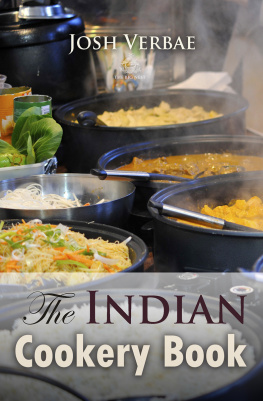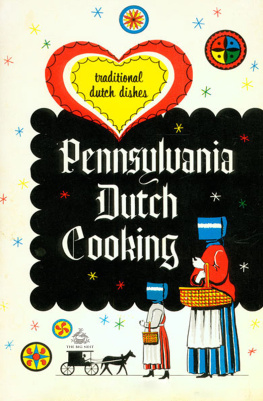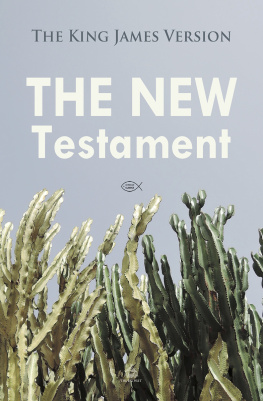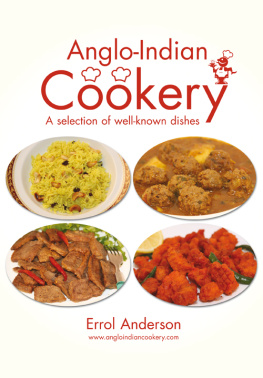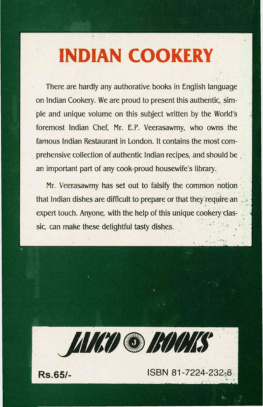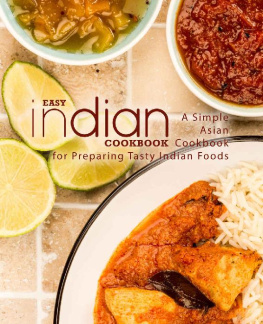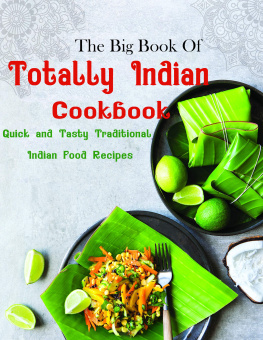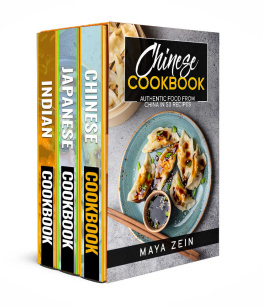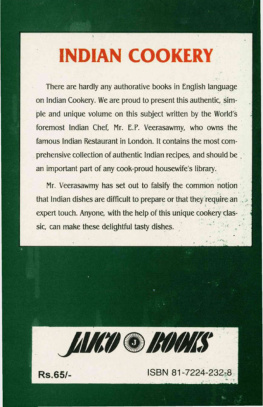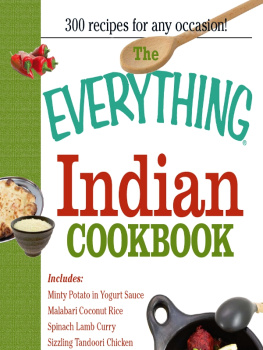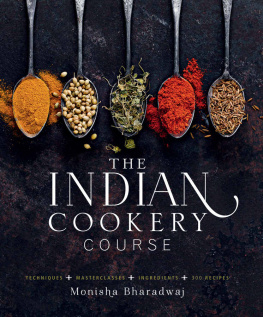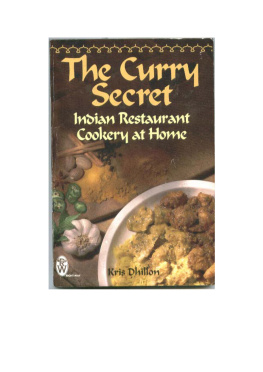
Josh Verbae
The Indian Cookery Book
New Edition


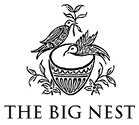
THE BIG NEST
LONDON NEW YORK TORONTO SAO PAULO MOSCOW
PARIS MADRID BERLIN ROME MEXICO CITY MUMBAI SEOUL DOHA
TOKYO SYDNEY CAPE TOWN AUCKLAND BEIJING
New Edition
Published by The Big Nest
sales@thebignest.co.uk
www.thebignest.co.uk
This Edition first published in 2014
Author: Unknown
Editor: Josh Verbae
Copyright 2014 The Big Nest
Cover design and artwork 2014 Urban-Pic.co.uk
Images and Illustrations 2014 Stocklibrary.org
All Rights Reserved.
ISBN: 9781910150405 (ebk)
Contents
THE RECIPES
RICE OR CHOWL
Rice is consumed by most European families at breakfast, tiffin, and dinner. It is eaten at breakfast with fried meat, fish, omelet, country captain, or some other curried dish, and, being invariably followed by toast and eggs, jams, fruit, &c., one coonkee, which contains about as much as an ordinary breakfast-cup, or say half a pound, will always be ample for four tolerably hearty consumers. There are two sizes of coonkees, large and small: reference is here made to the small coonkee, well filled. The quantity, however, of raw rice for a party of four should not exceed half a pound.
The rice at dinner is usually preceded by soup, fish, roast, and made dishes.
The best or generally approved qualities of rice for table use are known as the bhaktoolsee, the banafool, the bassmuttee, and cheeneesuckur. In purchasing these, or indeed any other approved quality, care must be taken to avoid new rice and what is called urruah, which latter has been put through some process of boiling, or damped, and then dried. Both are considered unwholesome for general daily consumption, and few Indians will use them.
Good rice when rubbed in the palm of the hand, and cleared of dust, will appear of a bright and nearly transparent yellowish colour; whereas the urruah will be found of a dull whitish hue, and the grain streaked and speckled with white powder, which crumbles on the application of a needles point.
The price of rice, like other commodities, varies according to its plenty or scarcity in the market. After the cyclone of October, 1864, and again of November, 1867, the price of the bhaktoolsee and the banafool, which are fine, large, stout-grain rice, without being coarse, ruled at from eight to nine seers per rupee, and the bassmuttee and the cheeneesuckur at from seven to eight seers per rupee. The rice used by the poorest classes of the native population is of a very coarse description and incredibly cheap: within six weeks after the cyclone of November, 1867, it was readily procurable at twenty-five to thirty seers per rupee.
Rice is used in a variety of forms: it is boiled, made into kitcheeree, pellow, puddings, blanc mange, cakes, bread, &c.
The bhaktoolsee, the banafool, and other stout-grain rice are the best adapted for boiling. Boiled rice is called bhath.
The bassmuttee, cheeneesuckur, and all small and fine-grain rice are selected for kitcheeree, pellow, and puddings for childrens food, and for invalids.
The urruah is used in some houses in ignorance, but for the most part it is made into flour, and used for blanc mange, cakes, &c. The flour is abundantly procurable in the Calcutta markets, and is largely used by all native bakers in the making of bread.
Twenty-two to twenty-five seers of rice monthly, consuming it three times a day, entertainments included, will be ample for a party of four, allowing occasionally for a rice pudding.
It is necessary to wash rice thoroughly in several waters before using it, and a colander is very useful for draining away the water after washing the rice.
1.Boiled Rice
Wash half a pound or a coonkeeful of rice, and put it to boil in a large quantity of water, over a brisk fire. Immediately the rice begins to boil, the water will bubble up to the surface of the pot and overflow, carrying away quantities of scum and impurities. The cover of the pot should now be kept partially open, and the rice stirred to prevent an entire overflow of the water. On the subsiding of the water or the bubbling, the fire should be reduced, until it is satisfactorily ascertained that the grains of rice, without being pappy, are quite soft, when the pot should be removed from the fire and a quart of cold water be added. All the liquid, which is conjee, should then be drained, and the pot replaced over a gentle charcoal heat, to allow all moisture to evaporate, assisting the process by occasionally shaking the pot, or stirring its contents gently with a wooden spoon. Time to boil: half an hour.
The coonkee of rice when properly boiled will fill a good-sized curry or vegetable dish. The rice will be found quite soft, and yet every grain perfectly separate. Rice should never be cooked into a pap, excepting it is required for very young children; and leaving the grains hard or uncooked should be equally avoided.
A small pinch of pounded alum or fitkerree is used by some cooks with advantage to improve the whiteness of boiled rice.
2.Rice Conjee
The water in which rice is boiled should never be thrown away: it is nutritious and fattening for all cattle, horses included, and may be given daily to milch cows and goats with great advantage.
3.Rice Kheer
This is occasionally served upon the breakfast-table as a treat, but few Europeans care for it. It is made as follows:Thoroughly boil one coonkee or half a pound of the bassmuttee or the cheeneesuckur rice, then drain the water away, add two cups of pure cows milk, and put over a slow fire. As the rice begins to absorb the milk, two or three small sticks of cinnamon are put in, with one tablespoonful and a half to two tablespoonfuls of fine-quality white sugar. On the milk being entirely absorbed, the kheer is either turned out upon a dish and eaten hot, or put into a buttered mould, served up in shape, and eaten cold.
Kheer is sometimes cooked or boiled in milk only, but the foregoing recipe is supposed to be that more generally approved.
4.Pish-Pash
Pick and wash in several waters a coonkee or half a pound of the bassmuttee or other fine-grain rice; add to it, cleaned and cut up, a chicken, some sliced ginger, sliced onions, a few bay-leaves, some peppercorns, a few hotspice, a dessertspoonful of salt, one chittack or two ounces of butter, and water sufficient to cover the whole. Simmer over a slow fire until the chicken becomes perfectly tender and the rice quite pappy. Serve up hot. This is considered a most excellent and nutritious meal for invalids.
KITCHEEREES
These are occasionally substituted for boiled rice at breakfast, and are eaten with fried fish, omelets, croquets, jhal frezee, &c. They are prepared as follows:
5.Bhoonee Kitcheeree
Take rather more than three-quarters of a coonkee of bassmuttee or cheeneesuckur and half a coonkee of dal; or, if preferred, take the rice and dal in equal parts.
Take twelve large curry onions and cut them up lengthways into fine slices. Warm up two chittacks or four ounces of ghee (but before doing so be careful to warm the pot), and, while bubbling, throw in the sliced onions, removing them immediately they become of a bright brown colour. Set the fried onions aside, and throw in the dal and rice (having previously allowed all the water in which they were washed to drain through a colander). Fry until the dal and rice have absorbed all the ghee; then add a few slices of green ginger, some peppercorns, salt to taste (say one dessertspoonful), a few cloves, three or four cardamoms, half a dozen bay-leaves, and as many small sticks of cinnamon. Mix well together; add as much water only as will entirely cover over the whole of the rice and dal, put a good-fitting cover on, and set over a slow fire, reducing the same from time to time as the water is being absorbed. Care must be taken not to allow the kitcheeree to burn, which may be prevented by occasionally shaking the pot, or stirring its contents with a wooden spoon.

